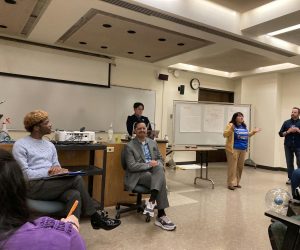America’s desensitization to mass shootings
December 3, 2019
Editor’s Note: Since we published this article three days ago, America has endured two more high-profile mass shootings. On Dec. 4, a shooting spree at the Pearl Harbor Naval Shipyard left three dead, three days ahead of the annual Pearl Harbor commemoration. Two days later, a shooter indiscriminately shot 11 people at the Naval Air Station in Pensacola, Fla., leaving four dead, including the perpetrator. Pearl Harbor National Memorial spokesperson Jay Blount stated that the commemoration event will proceed as planned.
The United States of America has developed an immunity to the impact of mass shootings.
Long gone are the days of extended press coverage following the indiscriminate slaying of American citizens. The exhibitions of camaraderie and national pride that used to accompany the needless loss of life have all but dissipated. In its place lives complacency bordering on apathy.
Between Nov. 14 and Nov. 18, America endured four separate mass shootings. The first occurred on Nov. 14 at Saugus High School in Santa Clarita, Calif., where two teenagers were killed and another three wounded.
Two days later, five members of the same family lost their lives to gun violence in San Diego, with three of the victims being under the age of 12.
The very next day, four lives were claimed in Fresno, Calif., at a football watch party. Six others were injured.
One day later, a gunman took the lives of two shoppers at a Walmart in Duncan, Okla., before turning the gun on himself.
What’s worse is that it has become hard to authentically care about the dire state of America. Of course we cringe at the thought of innocent Americans dying at the hands of senseless violence, but mass murders have become so common that we’ve become desensitized to the occasion. A few short years ago, a mass murder would stop America in its tracks, an occasion so chilling that we would voluntarily pause our daily routine in favor of displays of solidarity.
Today, such killings invoke a casual interest accompanied by a sigh of relief that we weren’t the unlucky ones. We hover over the headline and caption, distractedly pondering the location, underlying cause and number of lives claimed. Sometimes, we break the newly hardened mold and offer the deceased an artificial “R.I.P” before continuing our day, unencumbered by the tragedy that transpired.
Five dead Americans barely registers on our collective radars at this point. We’ve seen that before. It’s old news. For the devastation to truly resonate, we need an interesting caveat, something that deviates away from our dystopian norm. Once in a while we’ll see a hate crime so egregious that it inspires outrage. Other times, we will hear about a shooting that claimed such a staggeringly large amount of victims that it shocks us into caring. However, before we do, we make sure to hop on social media and offer a long-winded stance on gun control. Maybe we’ll even diverge from discussing the actual act of terrorism and debate the semantics of firearm categorization.
But the reality of the situation is unsettling. According to Gun Violence Archives, as of Nov. 18, America has suffered through 371 mass shootings in 2019. On average, America sees more than 100 gun-related deaths per day. In other words, gun violence has become normalized in the United States, almost ingrained in our culture via a constitutional amendment that was composed during an era where muskets were the preeminent firearm.
However, our first-world counterparts don’t suffer from the same level of gun homicides. Compared to other developed nations such as the United Kingdom and Japan, the United States has exponentially higher rates of gun crime. For example, the United States civilian gun-death rate is 35 times higher than the UK and 53 times higher than Japan.
America suffers from both a series of lax gun laws riddled with loopholes and a culture indoctrinated to believe gun violence is an inevitability. In a previous article, we detailed some of the loopholes that hamper the United States’ effort to curtail gun crime. For example, of the 51 states (including Washington D.C.), only nine states mandate that gun owners register their firearms. Only 15 states require a permit in order to purchase a gun. In 30 states, you can completely bypass a background check should a private buyer purchase a firearm from a private dealer, a loophole also known as the “gun show loophole”.
But we can argue about the effectiveness of gun legislation until we are blue in the face. We can reject the ethical foundation of our lawmakers accepting donations from organizations with the sole purpose of expanding gun accessibility. We can mock the idea of gun ban, claiming such a ban would only incentivize criminals. Regardless of what side of the ideological spectrum you lay on, one thing is certain: Americans are dying from gun violence at an unprecedented rate and we no longer care like we once did.
But it is about time that America challenges itself as a nation. The fact that we are entertaining ideas of providing every American with a firearm to counteract gun crime should alert us to the seriousness of the matter. The fact that parents are willing to standardize active shooter drills while sending their children to school with bulletproof backpacks rather than address gun violence head on is astonishing. It’s time that America conducts an internal investigation and eradicates the issues that are exacerbating gun violence. Truthfully, we might be too far gone for gun legislation reform to have any meaningful, tangible impact. However, we must make an attempt to curtail this deadly trajectory.
At the very least, we must try.








Keith • Dec 4, 2019 at 9:28 am
You are correct in stating that introducing additional gun legislation will lack significant impact. That truth is validated by the first three mass shooting examples you listed: Saugus, San Diego, and Fresno. Anyone who knows anything about gun laws realizes that California has the most draconian gun restrictions in the nation, yet they have experienced multiple shooting events in 2019. If more restrictive laws were the solution to misuse of firearms, then California would be a modern-day firearms utopia.
It’s not. Far from it, in fact.
I subscribe to Lt. Col. Jeff Cooper’s wisdom: “If violent crime is to be curbed, it is only the intended victim who can do it. The felon does not fear the police, and he fears neither judge nor jury. Therefore what he must be taught to fear is his victim.” First repsonders – that is, those people who are the targets of violence – should have some training in self-defense and self-protection in addition to understanding basic lifesaving skills. It is not the government’s job to protect us from every potential act that could be perpetuated against us. We need to re-embrace the basic notion of personal responsibility for our safety.